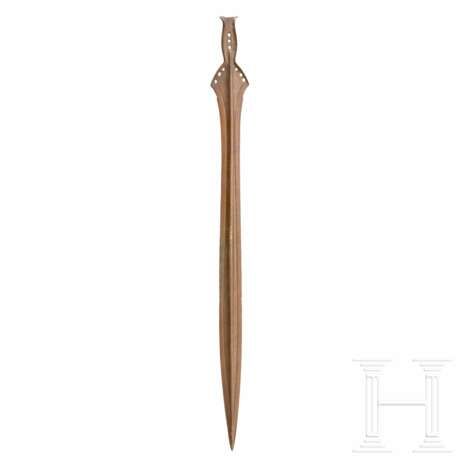Griffzungenschwert vom Typ Hemigkofen, Urnenfelderzeit (Hallstatt A), 12. - 11. Jhdt. v. Chr.
14.05.2024 10:00UTC +01:00
Classic
Sold
6200EUR € 6 200
| Auctioneer | Hermann Historica |
|---|---|
| Event location | Germany, Grasbrunn / München |
| Buyer Premium | 25 % |
Archive
The auction is completed. No bids can be placed anymore.

ID 1198588
Lot 65 | Griffzungenschwert vom Typ Hemigkofen, Urnenfelderzeit (Hallstatt A), 12. - 11. Jhdt. v. Chr.
Geschweifte Klinge mit maximalem Durchmesser im vorderen Drittel, was das Stück besonders für den Hiebgebrauch geeignet machte. Markante Mittelrippe, die sich bis in den Griffbereich fortsetzt. Diese von einer Ritzlinie, die im Abstand von ca. 8 mm parallel zur Schneide verläuft, begrenzt. Entlang der Spitze ist die dort ca. 2 mm breite Schneide vom stärkeren Mittelteil abgesetzt.
Trapezoide Griffplatte, von der Schneide unten durch einen markanten Einzug abgesetzt. Darüber bauchige Griffzunge mit drei Nietlöchern, die an den oberen Enden deutlich zur Seite hin auszipfelt. Auf der Griffplatte links und rechts entlang der Oberkante je drei Nietlöcher.
Griffplatte und Griffzunge durch eine 8 mm breite Randleiste begrenzt, die mit den Nietlöchern zur Aufnahme von Griffschalen aus organischem Material diente. Länge 64,7 cm. Maximale Breite an der Griffplatte 6 cm. Oberfläche mit minimalen Korrosionsnarben. Minimale Ausbrüche an den Schneiden. Die Oberfläche mit einer typischen rotbraunen "Moorpatina" überzogen, die für eine einstige Deponierung im feuchten Milieu spricht. Ausgezeichnet erhaltenes, attraktives Bronzeschwert.
Provenienz: Aus alter belgischer Privatsammlung, erworben im belgischen Kunsthandel in den 80er Jahren.
A bronze sword of the Hemigkofen type, Urnfield period (Hallstatt A), 12th - 11th century B.C.
A bronze sword of the Hemigkofen type, Urnfield period (Hallstatt A), 12th - 11th century B.C.
Curved blade with maximum diameter in the front third, which made the piece particularly suitable for cutting use. Distinctive midrib that continues into the handle area. This is bordered by a scoring line that runs parallel to the cutting edge at a distance of approx. 8 mm. Along the tip, the cutting edge, which is approximately 2 mm wide, is separated from the thicker middle part.
Trapezoidal handle plate, separated from the cutting edge at the bottom by a distinctive indentation. Above this there is a bulbous handle tongue with three rivet holes, which clearly flares out to the side at the upper ends. There are three rivet holes on the handle plate on the left and right along the top edge. The handle plate and handle tongue are bordered by an 8 mm wide edge strip, which, together with the rivet holes, was used to hold handle scales made of organic material. Length 64.7 cm. Maximum width at the handle plate 6 cm. Surface with minimal corrosion scars. Minimal chipping on the cutting edges. The surface is covered with a typical reddish-brown "moor patina", which suggests that it was once dumped in a moist environment. Excellently preserved, attractive bronze sword.
Provenance: From an old Belgian private collection, acquired in the Belgian art trade in the 80s.
Condition: I -
| Auction house category: | European Stone and Bronze Age |
|---|
| Auction house category: | European Stone and Bronze Age |
|---|
| Address of auction |
Hermann Historica Bretonischer Ring 3 85630 Grasbrunn / München Germany | ||||||||||||||
|---|---|---|---|---|---|---|---|---|---|---|---|---|---|---|---|
| Preview | |||||||||||||||
| Phone | +49 (0)89 5472 649 0 | ||||||||||||||
| Fax | +49 (0)89 5472 64999 | ||||||||||||||
| Buyer Premium | 25 % | ||||||||||||||
| Conditions of purchase | Conditions of purchase | ||||||||||||||
| Business hours | Business hours
|


